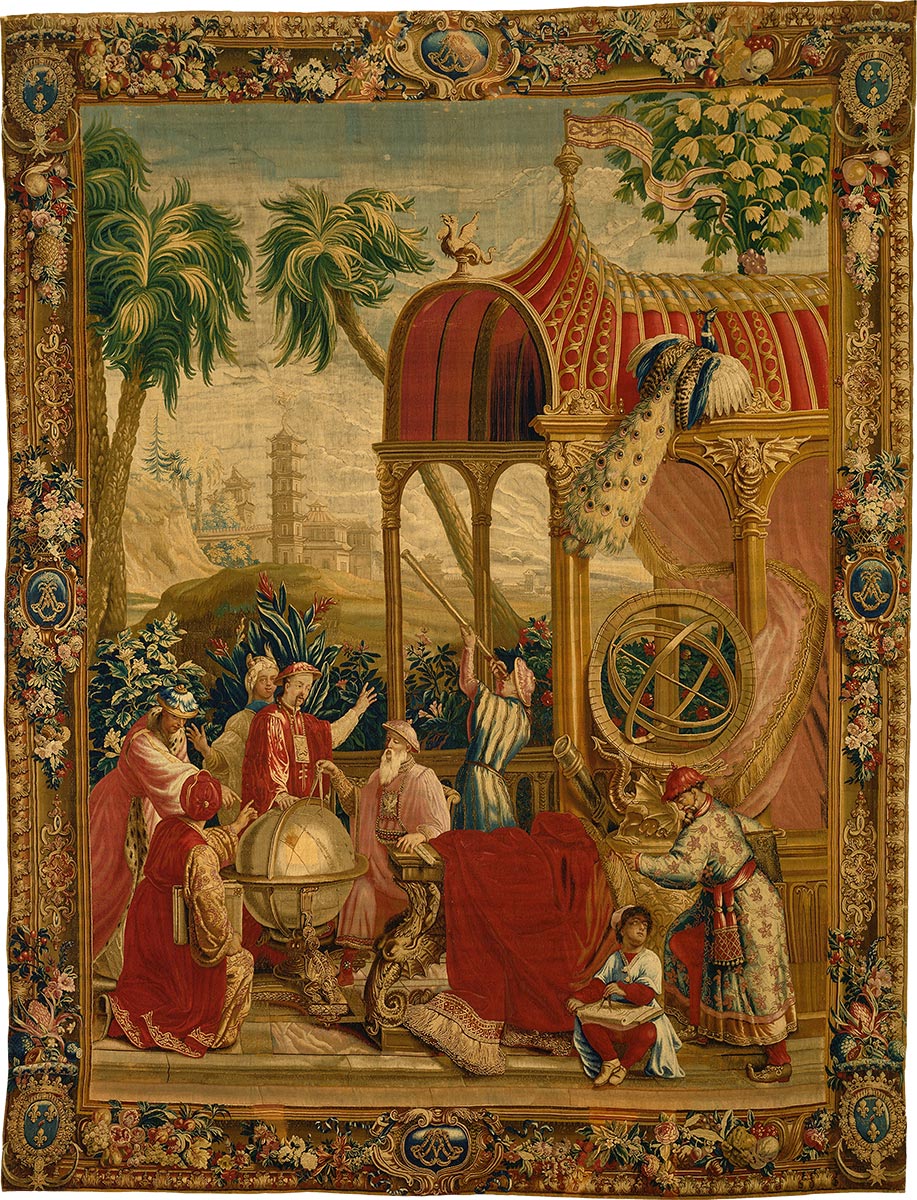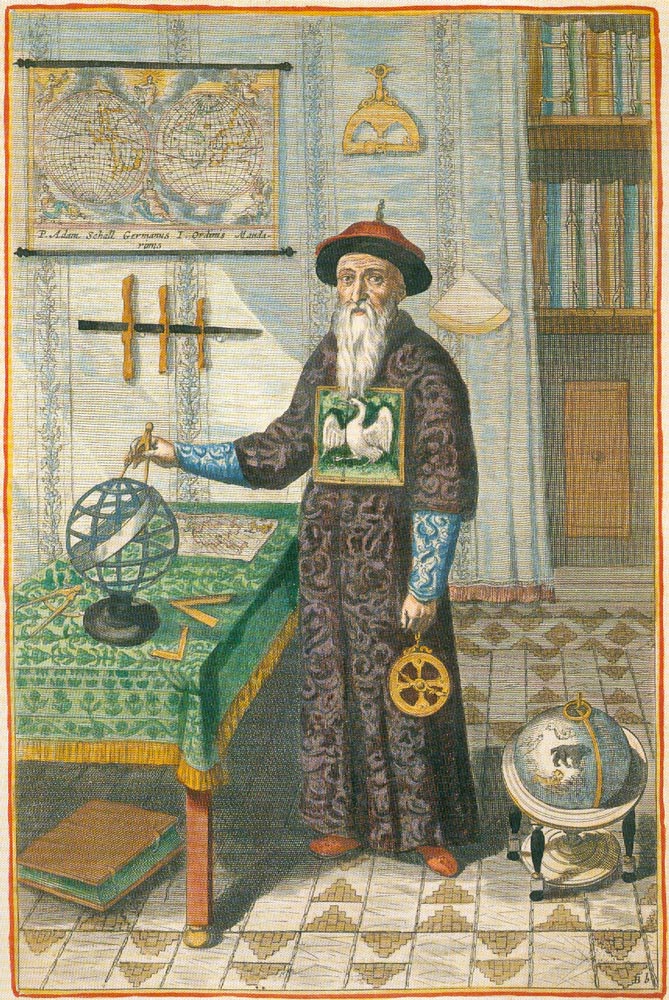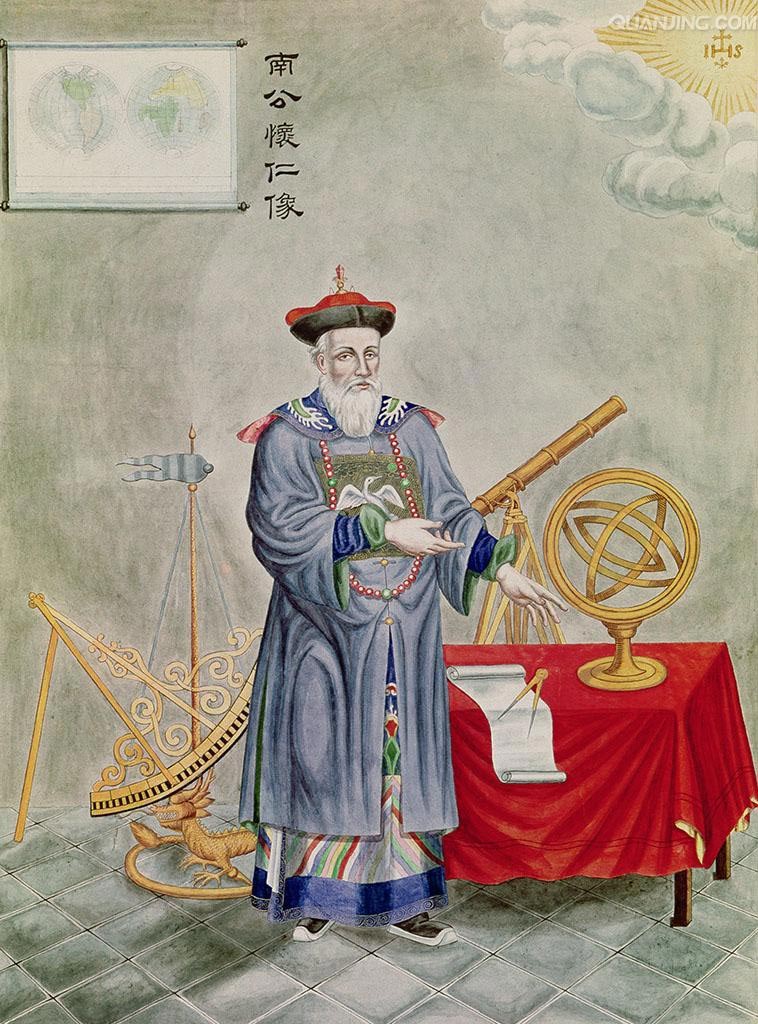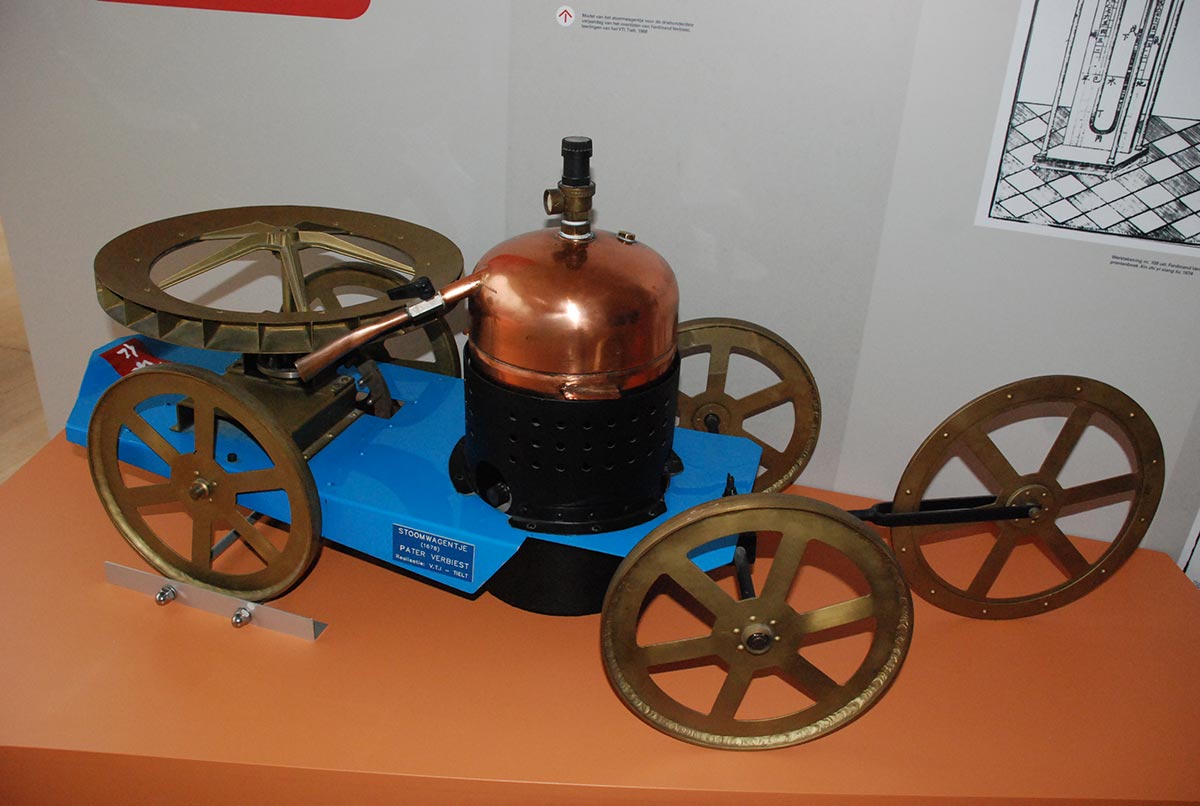For God or for the Emperor? A Flemish Jesuit at the 17th-Century Chinese Court
Last year marked the 400th anniversary of the birthday of the Jesuit missionary Ferdinand Verbiest, S.J. (1623-1688). Verbiest was born in Pittem, Belgium, and to mark the occasion, the old Ferdinand Verbiest Visitor’s Center in this small village in Flanders was turned into an Experience Center where visitors are immersed in the life and work of Verbiest. By refurbishing the space and through the inclusion of interactive functions, the new Experience Center provides a more realistic image of the period and environment in which this Belgian Jesuit lived. The objective is to create wider interest in Verbiest, and to keep his legacy alive. This is done, for instance, through copies of plans, drawings, and texts made by Verbiest. One of the most noteworthy pieces in the exposition is a small-scale model of Verbiest’s ‘mobile’ considered to be the first ‘car’.
As readers may know, Verbiest was instrumental in bringing European astronomy to the 17th-century court of the Chinese Qing dynasty (1644-1912). But during his long stay at the court of the Kangxi Emperor Xuanye 玄燁 (1654-1722), Verbiest’s influence stretched further. In the rear part of The Ferdinand Verbiest Experience Center, Verbiest is presented as a ‘homo universalis’, with exceptional engineering qualities.
The early years of Ferdinand Verbiest
Ferdinand Verbiest was born on October 9, as the son of a bailiff and tax collector for the local authorities. 1 Between 1634 and 1640 Verbiest studied with the Jesuits, first in Bruges and later in Kortrijk. In 1640 he attended the Collegium Liliense in Leuven, where he studied philosophy and mathematics. He soon interrupted his studies and entered the Jesuit Novitiate, where he formally joined the Jesuit Order on September 2, 1641. Already during his first year, he applied for the South American mission, but this was refused. Verbiest finished his studies at the Jesuit College of Leuven and returned to his former college in Kortrijk, where he studied as a repetens (a position in which a student repeats his knowledge under the supervision of a tutor).
In 1647 he received permission to go to the mission in Peru, but upon arrival in Cádiz, he learned that this permission had been withdrawn at the last minute. A disappointed Verbiest returned to his home country and was appointed professor of Latin and Greek at the Jesuit College in Brussels. Five years later he was selected to attend courses for his doctorate in theology at the Collegio Romano in Rome. In April 1655, Verbiest defended his doctoral dissertation in Sevilla, after which he returned to Rome. By now it had become clear to Verbiest that his appeals to be sent to the West Indies would remain fruitless, and he became attracted to the idea of joining the Jesuit missions in China. Therefore, he spent some time in Genoa, where missionaries for the Far East were prepared. Verbiest received training in mathematics, which was then considered the most important subject for these kinds of missions.
A first attempt to reach Lisbon – from where Verbiest and other missionaries would set sail for China – was hindered when their boat was attacked by pirates. Verbiest was held captive but finally succeeded in escaping. He then decided to travel overland to Lisbon, but he arrived too late for the spring departure of the fleet bound for the East. He accepted a temporary position as a professor of mathematics at the Colégio das Artes in Coimbra. Finally, on April 4, 1657, Verbiest and 16 other Jesuit missionaries left Lisbon. After a traumatic overseas journey and a stopover in Goa, they arrived in Macau on July 17, 1658.
Subsequently, he was sent from Macau to the Xi’an Mission in Shaanxi Province. Verbiest would not stay long in his newly appointed post, as in 1660 the Shunzhi Emperor Fulin 福臨 (1638-1661) requested that he continue on to Beijing. The main instigator for this move was Father Johann Adam Schall von Bell, S.J. (1582-1666), who had been sent to Beijing to continue the work of the deceased Johann Schreck, S.J. (1576-1630) on the reform of the Chinese calendar. Schall von Bell succeeded in modifying the Chinese calendar and compiling the Chongzhen calendar (named after the last emperor of the Ming Dynasty, the Chongzhen Emperor, Zhu Youjian 朱由檢,1611-1644). After the Ming-Qing Transition in 1644, Schall von Bell gained access to the newly installed Shunzhi Emperor and became one of his trusted counsellors. Feeling that his physical abilities were slowly failing, he looked for a replacement and finally decided on Ferdinand Verbiest. Verbiest left Xi’an on May 9, 1660 and arrived at the imperial city of Beijing on June 9. 2

Fig. 1: Les Astronomes [The Astronomers], Beauvais Tapestry Manufactory (c. 1697-1705). (Image in public domain, available from Getty Research Institute)
The Jesuits and the importance of the Chinese calendar
In Europe, Jesuits were known for their deep knowledge of mathematics and astronomy. This expertise gave them a favourable position in China, where the emperor was keen to get access to new ideas. But Jesuits felt that this advantage was not always enough to be totally accepted by Chinese society. In order to be successful in China, the Jesuits realised they needed to adapt their beliefs and practices to better accommodate their potential converts. 3 Another important element in the success of the Jesuits in China was their technological prowess, as they proved to be very good designers and builders of instruments.
At the same time the Jesuits understood very well that their unparalleled position also depended on sharing European knowledge with the emperor. The key element was the Chinese calendar and its defaults. The calendar problem stems from the fact that a year does not contain an exact number of months, and neither does a year nor a month contain an exact number of days. So, there are intercalations in every calendar. In Europe, ten days had been skipped in October 1582 in order to bring the calendar into agreement with celestial phenomena. But in China, it was about more than fixing the vernal equinox or holidays. The earth had to be in harmony with the heavens at all times. This was no mere superstition; rather, it reflected the view that agriculture depended on astronomical data. The emperor played a fundamental role in this, as he was the link between heaven and earth and was responsible for the harmony between the two. To carry out his decisions correctly, the accuracy of the calendar was critical. Thus, the Chinese sought the best scientists, even if they had to look far beyond the borders of the empire.
Troubles for Verbiest and the Jesuit Mission
The first years of Ferdinand Verbiest in China were not easy. One of his fellow Jesuits, Gabriel de Magelhães, S.J. (1610-1677), was imprisoned on suspicion of bribery. Meanwhile Schall von Bell endured attacks from Chinese and Muslim astronomers opposing his Western methods.
On April 20, 1664, Schall suffered a stroke and was barely able to move or speak. On September 15 of that year one state official, Yang Guangxian 楊光先 (?-1669), presented a petition to the Board of Rites charging Schall and his companions with treachery, preaching an abominable religion, and teaching false astronomical methods. Schall was arrested along with Ferdinand Verbiest, the two antagonists de Magalhães and Buglio, and a number of Chinese Christians associated with the Astronomical Bureau. After a lengthy trial before a court in Beijing, the prisoners were handed over to the Minister of Justice for sentencing. On February 4, 1665, three judges ratified the death sentence that had been given to Schall, only they changed the method from strangulation to the most barbarous of all deaths known to Chinese law: slowly cutting the victim to pieces with a sharp sword.

Figure 3: A colourised portrait of Adam Schall von Bell (c. 1667 CE), the Jesuit missionary and scholar who introduced Ferdinand Verbiest to the Chinese emperor. (Image in public domain, available from Wikimedia Commons)
For the next two months the prisoners were contemplating their fate when a series of remarkable events, including the apparition of a comet and an earthquake, occurred that spared their lives. As a result, an amnesty was granted on April 19, which included Ferdinand Verbiest, Buglio, de Magalhães, and one of the Chinese Christian officials. Four days later, Adam Schall’s death sentence was commuted. He remained in chains until, so it seemed, nature intervened once more: on April 29, fire raged in the imperial palace, where some forty rooms burnt out.
Adam Schall was released and allowed to return to his home. Nevertheless, five Chinese Christians from the Institute of Astronomy were beheaded, and 30 missionaries who had taken up residence in Beijing were banished to southern China. Only Verbiest and four other missionaries were permitted to remain outside the capital. However, Verbiest and Schall von Bell would not leave the capital anymore. The two of them stayed at the Jesuit residence where Schall von Bell would die on August 15, 1666. Yang Guangxian succeeded as the head astronomer at the court.
Beyond astronomy: on cannons and cars
Four years later, after heavy disputes, Verbiest managed to prove the mistakes in the calendars drawn by the Mathematical Bureau. As a result, Yang Guangxian was replaced by Verbiest, who started the process of replacing the old instruments in the observatory with six new ones, thus creating an observatory based on the ideas of Tycho Brahe. 4 Furthermore, Verbiest was appointed Director of the Astronomical Bureau, responsible for the calculation of the lunar calendar and for teaching the ‘Western Rule’ to the students of the Bureau.
Soon, the Kangxi Emperor would ask Verbiest’s assistance in matters related to mechanics, hydraulics, ballistics, and kinetics. One of Verbiest’s most noteworthy realisations as an engineer was his success in transporting four massive granite blocks over the Lugou Bridge (also known as “The Marco Polo Bridge”, spanning the Yongding River 永定河, appr. 15 kms southwest of Beijing). To accomplish this, he used a combination of men (instead of horses) and windlasses, which helped confirm his reputation with the emperor as a man capable of many things.
More controversially, Verbiest assisted in drawing the much-needed cannons for use in the emperor’s war with insurgents in various parts of his empire. In 1673 Wu Sangui 吳三桂 (1612-1678) the general who was in charge of the garrison of Yunnan province, rose in rebellion with the purpose of disrupting the vast Chinese empire. Geng Jingzhong 耿精忠 (1644-1682) and Shang Zhixin 尚之信 (1636-1680) answered his call to rebellion. Soon half of China’s territory was swept with warfare. The emperor realised that in order to repress the rebellion, the Qing army would require mobile and agile cannons, and he asked Verbiest to take part in the casting of light cannons.
Of the total of 905 cannons manufactured during the Kangxi reign, more than half were cast under Verbiest’s supervision. 5 He presented a model of a wooden cannon, which consisted of an iron barrel, of which the mouth was equipped with a bronze ring, while a bronze ball was added to the rear part. The whole was covered by painted wood. Verbiest also cast ‘Dutch cannons’, named after the cannons that had been imported from Holland in 1604. But these cannons proved to be too heavy for fast warfare. The wooden model was successful, and between 1674 to 1676 Verbiest oversaw the production of 132 wooden cannons, followed by another 320 cannons. In 1681, Verbiest tested a new type of cannon. To meet the high standards set by the emperor, Verbiest made numerous calculations for measuring distance, and for improving accuracy and mobility. In order to get the most out of these new cannons, Verbiest designed new four-wheeled chariots to transport the cannons and support them while being fired.
His success in casting cannons earned Verbiest the title of Engineer. In 1682, Verbiest wrote a (now lost) book, drawing on his experiences and explaining the theory and method of firing cannons. The technique, shape and solid body of Verbiest’s light cannons were unparallelled and improved only much later, showing that Verbiest was creatively devoted to the casting of low-weight and easily transportable cannons.

Fig. 4: Ferdinand Verbiest, represented as a Mandarin and as astronomer. (Image in public domain, retrieved here)
Verbiest's engineering and technical skills are also apparent in his design of the first-ever self-driving mobile (or ‘car’), meant to divert the emperor who had a keen interest in technique and engineering. Verbiest’s description in his Astronomia Europaea (Dilingen, 1687) contains the earliest dated technical description of an automotive device. 6 Verbiest did not want to present a mere model: he designed a vehicle consisting of a number of parts with a definite function. The most impressive part of his machine was that it used mechanical power, containing within itself the means of propulsion. For this, Verbiest used a small steam turbine, positioned on a light wooden chassis. 7 He combined older scientific inventions and knowledge, applying his original mind and technical skills. This shows how he was able to bring together various aspects of science and engineering. The most important elements of his car were made of steel, built on a light wooden chassis.
Many sources have defined Verbiest’s machine to be the first car. Even today car constructors and websites on car mechanics refer to this invention as the first self-running car. Recent experiments have shown that, with some safety adjustments, Verbiest’s automotive was capable of running by itself. 8 Although it does not match the exact definition of a modern car, this machine was only one of Verbiest’s many technological triumphs.

Fig. 5: A small-scale reproduction of Verbiest's car, made by students from the School for Technics (VTI), Tielt, Belgium. (Photo courtesy of Gemeente Pittem, 2023.
While Verbiest only consented to working for the emperor because he believed this would help him receive permission to spread Christianity, this caused much fuzz among some of his fellow brothers, who accused him of devoting too much time to worldly affairs, of receiving and distributing presents, and of accepting non-religious titles.
Verbiest fell from his horse in 1887 and, as a consequence, was left in severe pain. He would never fully recover and died on January 28, 1688. He was succeeded as the chief mathematician and astronomer of the Chinese empire by another Belgian Jesuit, Antoine Thomas, S.J. (1644–1709). Verbiest was buried in the Jesuits’ Zhalan Cemetery in Beijing, near other Jesuits including Matteo Ricci and Johann Adam Schall von Bell. His funeral was paid for by the emperor himself.
Importance of Verbiest for Chinese science
In retrospect one might conclude that Verbiest promulgated outdated knowledge to China. This, however, requires nuance. First and foremost, he tried to get as many books and other scientific writings from Europe to China as possible, with varying success. One problem was that even in Europe, the distribution of new scientific ideas did not evolve very fast. During Verbiest's lifetime, some universities refused to teach the new insights of Copernicus and others. Moreover, of course, there was the enormous distance between Europe and China, which made the transfer of knowledge enormously difficult. Shortly after Verbiest left for China, numerous instruments were developed in the fields of time measurement, angle measurement, and optics. It took decades for these inventions to reach China, time that the emperor did not grant Verbiest.
While most biographical notes on Verbiest stress his importance for the knowledge Chinese astronomers gained from him, we should not overlook the other fields in which his contributions were far from trifle. In fact, his importance was not only scientific but also technical. While in many publications he is called a scientist, it is more appropriate to label Verbiest as an engineer.
Patrick Vanden Berghe (M.A. English literature) is head librarian of the Public Library of Pittem and an independent researcher. His interest focusses on Ancient South-East Asian history. He participated in the restyling of the Ferdinand Verbiest Experience Center in Pittem (Belgium). Email: patrickvandenberghe@gmx.net